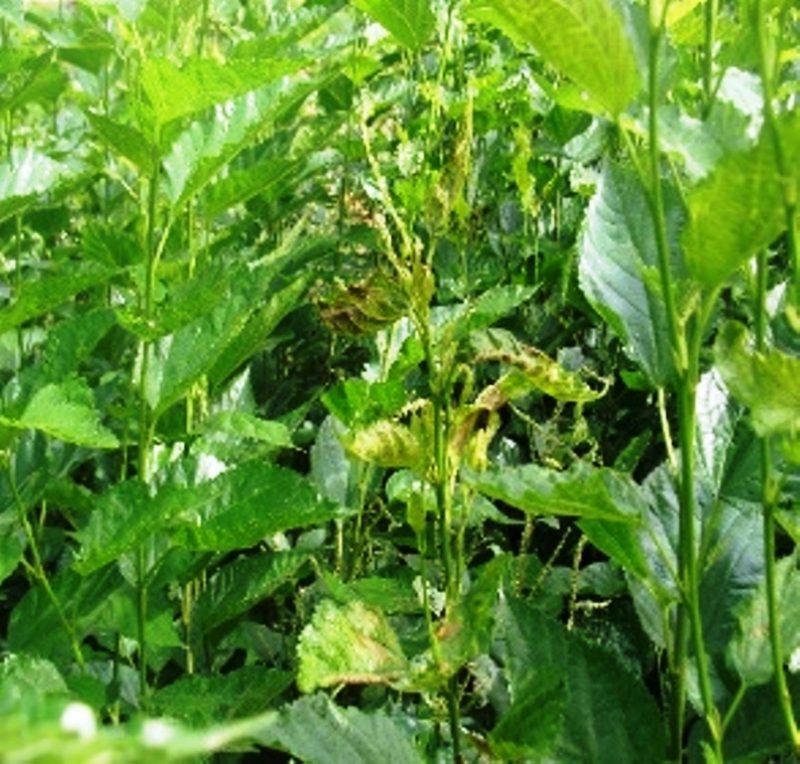The increase in productivity of silk per unit area can be achieved by adopting suitable production technologies, combined with eco-friendly management of pests and diseases in mulberry and silkworm.
Over 300 insect and non-insect pests have been reported to attack mulberry. Among them mite infestation in mulberry adversely affects the economic characters of silkworm and cocoon. The larval weight, cocoon weight, shell weight, shell ratio, filament length and denier were found to be significantly affected when the silkworm were fed with mite infested leaves as compared to healthy leaves.
Most predominant mite species occurring in mulberry is Polyphagotarsonemus latus (Banks). Though P. latus was reported on jute as a serious pest since 1940, it is reported on mulberry only in 2002. P. latus is a major pest in chilli and also known to attack more than 250 species of plants. It is popularly known as yellow mite, broad mite, chilli mite, etc.
Seasonal incidence: The incidence of yellow mite on mulberry varies with training type. Incidence of yellow mite on bush type of mulberry is observed from June and attains maximum peak in November. Whereas on tree type of mulberry maximum incidence is observed in August. The infestation of yellow mite is influenced by weather factors like temperature, relative humidity and rainfall. Relative humidity plays a significant role.
Nature and Extent of Damage: The yellow mite exhibited the symptoms of damage only on the bush type of mulberry. Therefore, there could be strong relationship between the type of cultivation of mulberry crop and the incidence of the mite pest. In both tree and bush type of mulberry, yellow mite is observed only in the top canopy (top 6-7 leaves).
The top canopy leaves of mulberry are soft and succulent with high moisture content as compared to middle and bottom leaves, which would have facilitated the individuals of yellow mite to confine themselves to the top leaves for sucking the sap. More commonly the mite feeds on the lower surfaces, which consequently curl downwards.
The foliage becomes rigid or bronzed and assumes a shrivelled and scorched aspect. Whereas the apical leaves are heavily damaged, the growth is distorted and die, similarly in case of the buds. Blistering, crinkling and development of dark colour follows mite attack. Injury symptoms induced by the mite also continued even after the pest has been eliminated by the pesticidal treatments.

Life cycle: The life stages of yellow mite includes egg, larva, quiescent1 and adult stages.
a) Egg: The egg is oval in shape with 8 to 10 rows of tubercles arranged longitudinally. The colour of the egg remained white from the time of egg laying up to hatching. The eggs are attached to the base of the midrib of mulberry leaf. The length and breadth are 119.50 µm and 70.38 µm, respectively. The incubation period ranges from 40.05 h to 41.33 h.
b) Larva: The larva of the yellow mite is spindle shaped, with milky white colour and longitudinal mid-dorsal white band. It has three pairs of legs. The length and breadth of the larva are 216.53 µm and 130.76 µm, respectively. The duration of larva ranges from 22.68 h to 22.37 h.
c) Quiescent 1: Quiescent 1 is a resting stage in the life cycle of mite, it is also called as chrysalis. The quiescent is spindle shaped and pointed at both ends. Longitudinal mid-dorsal white band is reduced and having an hour glass shape. The male carries the female quiescent before it becomes adult female. This behaviour is known as copulatory guarding. The length and breadth of the quiescent are 286.14 µm and 130.38 µm, respectively. The duration of male and female quiescent stage ranges from 15.08 to 15.28h, respectively. This stage of the mite is the shortest duration in the life-cycle.
d) Adult: The male adult has the prominent four pairs of spider like legs, it is highly motile compared to adult female. The colour of the male adult is golden yellow in colour. The length and breadth are 188.84 µm and 124.30 µm, respectively. The female adult has four pairs of legs. The body of the mite appears glossy with golden yellow colour because of sclerotization. Depression is seen on the dorsal side of the body. The length and breadth are 194.45 µm and 115.69 µm, respectively.
Predatory mites in mulberry ecosystem: Three predatory mites viz., Neoseiulus longispinosus (Evans,1952), Euseius ovalis (Evans, 1953), Amblyseius sp. have been identified in mulberry ecosystem.
Management of yellow mite
1. Maintenance of optimum plant density in the mulberry gardens.
2. Removal of alternate hosts/weeds in the vicinity of mulberry gardens.
3. Spray propargite 57EC @ 1.5ml per litre of water by drenching all the apical leaves of mulberry plant. If the infestation is severe, repeat the same spray with an interval of seven days from the first spray.
4. However, the mulberry leaves sprayed with propargite 57 EC @ 1.5 ml litre of water are safe to silkworm after 16 days of last spray.
Authors: M. Sharath, Dr. K.C. Narayanaswamy and Dr. Manjunath Gowda
Department of Sericulture, College of Agriculture, GKVK, UAS Bangalore-560065
Email: [email protected] Mob. No. 8971496497



































